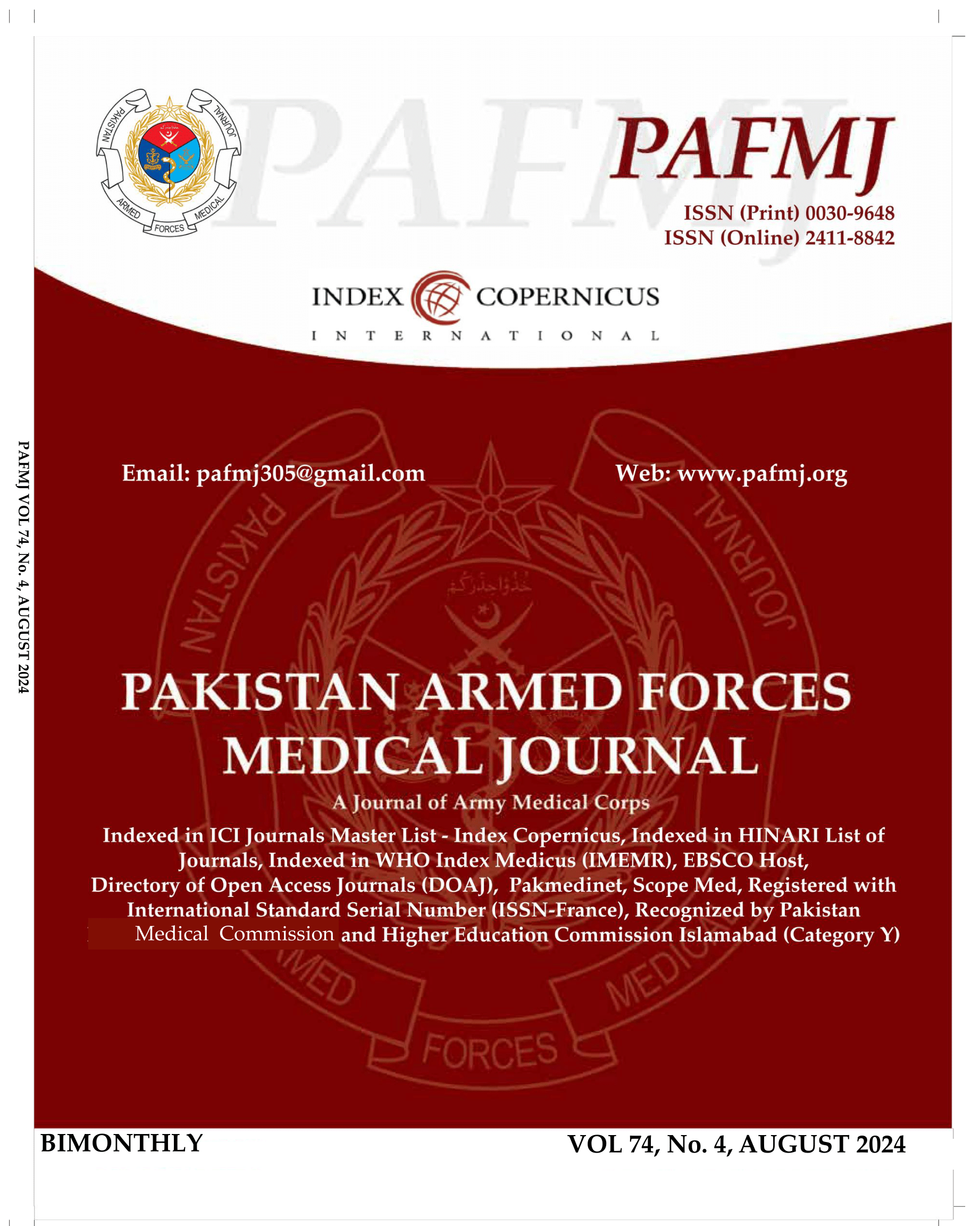C-Reactive Protein as A Useful Predictor of Difficult Laparoscopic Cholecystectomy
DOI:
https://doi.org/10.51253/pafmj.v74i4.9690Keywords:
Cholecystectomy, C-reactive protein, Frequency, Laparoscopic cholecystectomy.Abstract
Objective: To determine the ability of C-reactive protein as a useful predictor of difficult laparoscopic cholecystectomy.
Study Design: Cross sectional study.
Place and Duration of Study: General Surgery unit of Combined Military Hospital, Rawalpindi Pakistan, from Nov 2021–Nov 2022.
Methodology: Fifty-six patients who underwent emergency or early laparoscopic cholecystectomy were made part of this study. After an informed consent age, gender, Body Mass Index and C-Reactive Protein levels were documented. Patients then underwent surgery and operative time along with “Nassar Difficulty Grade” was documented to define difficult cholecystectomy.
Results: A total of 56 patients who were scheduled to undergo laparoscopic cholecystectomy were included with mean age of 44.32±5.37 years. 23(41.10%) were male patients while 33(58.90%) were female patients. Mean CRP levels were 20.00±8.81 mg/L. Frequency of "difficult laparoscopic cholecystectomy" in patients who had high preoperative CRP was 15/22(68.18%) while in patients who had low preoperative CRP it was 13/34(38.23%). Additionally, bivariate analysis of CRP levels and mean operative time showed that Pearson correlation coefficient (r) value was 0.355 showing a significant positive correlation (p=0.007).
Conclusion: C-reactive protein levels in patients undergoing laparoscopic cholecystectomy for gallstones or any of its related problems are helpful in predicting whether or not the patient will have a challenging laparoscopic cholecystectomy.
Downloads
References
Futara G, Kinfu Y. Anatomical variations of gallbladder and biliary ducts among Ethiopians. Ethiop Med J 2001; 39(3): 173-184.
Tsai TJ, Chan HH, Lai KH, Shih CA, Kao SS, Sun WC, et al. Gallbladder function predicts subsequent biliary complications in patients with common bile duct stones after endoscopic treatment? BMC Gastroenterol 2018; 18(1): 32. https://doi.org/10.1186/s12876-018-0762-6
Song ST, Shi J, Wang XH, Guo YB, Hu PF, Zhu F, et al. Prevalence and risk factors for gallstone disease: A population-based cross-sectional study. J Dig Dis 2020; 21(4): 237-245.
https://doi.org/10.1111/1751-2980.12857
Song Y, Ma Y, Xie FC, Jin C, Yang XB, Yang X, et al. Age, gender, geographic and clinical differences for gallstones in China: a nationwide study. Ann Transl Med 2022; 10(13): 735.
https://doi.org/10.21037/Fatm-21-6186
Lodha M, Chauhan AS, Puranik A, Meena SP, Badkur M, Chaudhary R, et al. Clinical profile and evaluation of outcomes of symptomatic gallstone disease in the senior citizen population. Cureus 2022; 14(8): e28492.
https://doi.org/10.7759/cureus.28492
Ukegjini K, Schmied BM. Diagnostik und Behandlung der akuten Cholezystitis [Diagnosis and treatment of acute cholecystitis]. Ther Umsch 2020; 77(4): 133-146.
https://doi.org/10.1024/0040-5930/a001168
Lee SO, Yim SK. Management of acute cholecystitis. Korean J Gastroenterol 2018; 71(5): 264-268.
https://doi.org/10.4166/kjg.2018.71.5.264
Mou D, Tesfasilassie T, Hirji S, Ashley SW. Advances in the management of acute cholecystitis. Ann Gastroenterol Surg 2019; 3(3): 247-253. https://doi.org/10.1002/ags3.12240
Bhondave ST, Dash N, Thipse VJ, Gadekar JM. Proposed diagnostic scoring system to predict difficult laparoscopic cholecystectomy. J Med Sci Clin Res 2017; 5(12): 31682-31688.
da Costa DW, Schepers NJ, Bouwense SA, Hollemans RA, van Santvoort HC, Bollen TL, et al. Dutch Pancreatitis Study Group. Predicting a 'difficult cholecystectomy' after mild gallstone pancreatitis. HPB 2019; 21(7): 827-833.
https://doi.org/10.1016/j.hpb.2018.10.015
Di Buono G, Romano G, Galia M, Amato G, Maienza E, Vernuccio F, et al. Difficult laparoscopic cholecystectomy and preoperative predictive factors. Sci Rep 2021; 11(1): 2559.
https://doi.org/10.1038/s41598-021-81938-6
Stirling AD, Moran NR, Kelly ME, Ridgway PF, Conlon KC. The predictive value of C-reactive protein (CRP) in acute pancreatitis - is interval change in CRP an additional indicator of severity? HPB 2017; 19(10): 874-880.
https://doi.org/10.1016/j.hpb.2017.06.001
Sproston NR, Ashworth JJ. Role of C-reactive protein at sites of inflammation and infection. Front Immunol 2018; 9: 754.
https://doi.org/10.3389/fimmu.2018.00754
Kaushik B, Gupta S, Bansal S, Yadav BL, Bharti D, Kalra D, et al. The role of C-reactive protein as a predictor of difficult laparoscopic cholecystectomy or its conversion. Int Surg J 2018; 5(6): 2290-2294.
https://doi.org/10.18203/2349-2902.isj20182239
Nehring SM, Goyal A, Patel BC. C Reactive Protein. In: StatPearls. Treasure Island: StatPearls Publishing; 2022.
Gupta S, Anand K, Paliwal P, Baghel AS. Validation of intra-operative scoring system for difficult laparoscopic cholecystectomy. Int Surg J 2022; 9(11): 1842-1850.
https://doi.org/10.18203/2349-2902.isj20222939
Griffiths EA, Hodson J, Vohra RS, Marriott P, Katbeh T, Zino S, et al. West Midlands Research Collaborative. Utilisation of an operative difficulty grading scale for laparoscopic cholecystectomy. Surg Endosc 2023; 33(1): 110-121.
https://doi.org/10.1007/s00464-023-09888-w
Díaz-Flores A, Cárdenas-Lailson E, Cuendis-Velázquez A, Rodríguez-Parra A, Trejo-Avila ME. C-Reactive protein as a predictor of difficult laparoscopic cholecystectomy in patients with acute calculous cholecystitis: a multivariate analysis. J Laparoendosc Adv Surg Tech 2017; 27(12): 1263-1268.
Downloads
Published
Issue
Section
License
Copyright (c) 2024 Waleed Umer, Rifaat Qamar Naqvi, Fahad Shakil, Mansoor Tariq

This work is licensed under a Creative Commons Attribution-NonCommercial 4.0 International License.















